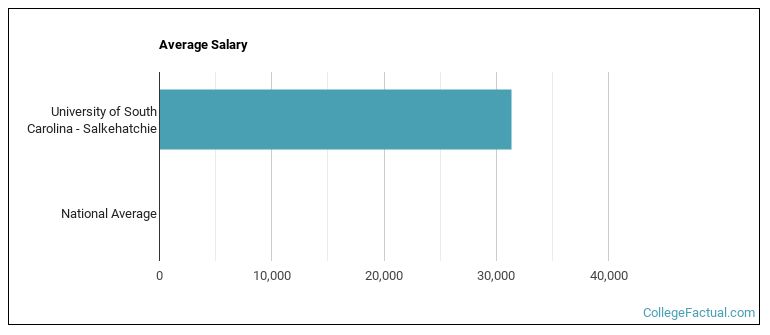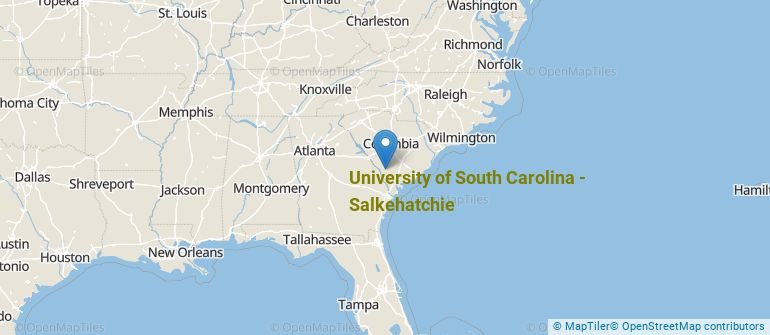 by our College Data Analytics Team
by our College Data Analytics TeamExplore the best ranked schools for the programs you are most interested in.
According to College Factual's 2025 analysis, USC Salkehatchie is ranked #1,930 out of 2,152 schools in the nation that were analyzed for overall quality.
See all of the rankings for University of South Carolina - Salkehatchie.
University of South Carolina - Salkehatchie has an acceptance rate of 71%, which makes it somewhat selective. Make sure it's not the only school you apply to, even if it's your school of choice. Whether you get in or not will largely depend on how you compare to other applicants.
The student to faculty ratio is often used to estimate how much interaction there is between professors and their students at a college or university. At University of South Carolina - Salkehatchie, this ratio is 14 to 1, which is on par with the national average of 15 to 1. That's not bad at all.
When estimating how much access students will have to their teachers, some people like to look at what percentage of faculty members are full time. This is because part-time teachers may not have as much time to spend on campus as their full-time counterparts.
The full-time faculty percentage at University of South Carolina - Salkehatchie is 47%. This is comparable to the national average of 47%.
The freshmen retention rate of 42% tells us that most first-year, full-time students don't stick around for a second year at University of South Carolina - Salkehatchie. Students may have a variety of reasons for this, such as only intending to attend a school for one year while they brush up on certain subjects.
During the 2017-2018 academic year, there were 878 undergraduates at USC Salkehatchie with 454 being full-time and 424 being part-time.
| $0-30 K | $30K-48K | $48-75 | $75-110K | $110K + |
|---|---|---|---|---|
| $9,181 | $10,408 | $13,975 | $16,845 | $17,775 |
The net price is calculated by adding tuition, room, board and other costs and subtracting financial aid.Note that the net price is typically less than the published for a school. For more information on the sticker price of USC Salkehatchie, see our tuition and fees and room and board pages.
While almost two-thirds of students nationwide take out loans to pay for college, the percentage may be quite different for the school you plan on attending. At USC Salkehatchie, approximately 40% of students took out student loans averaging $5,356 a year. That adds up to $21,424 over four years for those students.
Get more details about paying for University of South Carolina - Salkehatchie.

See which majors at University of South Carolina - Salkehatchie make the most money.
Get more details about the location of University of South Carolina - Salkehatchie.

Contact details for USC Salkehatchie are given below.
| Contact Details | |
|---|---|
| Address: | 465 James Brandt Blvd, Allendale, SC 29810-0617 |
| Phone: | 800-922-5500 |
| Website: | sc.edu/about/system_and_campuses/salkehatchie/index.php |
| Facebook: | https://www.facebook.com/uofsc |
| Twitter: | https://twitter.com/UofSC |
| Most Popular Majors | Bachelor’s Degrees | Average Salary of Graduates |
|---|---|---|
| Liberal Arts General Studies | 110 | NA |
Online courses area a great option for busy, working students as well as for those who have scheduling conflicts and want to study on their own time. As time goes by, expect to see more and more online learning options become available.
In 2022-2023, 562 students took at least one online class at University of South Carolina - Salkehatchie. This is a decrease from the 649 students who took online classes the previous year.
| Year | Took at Least One Online Class | Took All Classes Online |
|---|---|---|
| 2022-2023 | 562 | 252 |
| 2021-2022 | 649 | 205 |
| 2020-2021 | 626 | 115 |
| 2018-2019 | 290 | 49 |
Learn more about online learning at University of South Carolina - Salkehatchie.
Footnotes
*The racial-ethnic minorities count is calculated by taking the total number of students and subtracting white students, international students, and students whose race/ethnicity was unknown. This number is then divided by the total number of students at the school to obtain the racial-ethnic minorities percentage.
References
More about our data sources and methodologies.